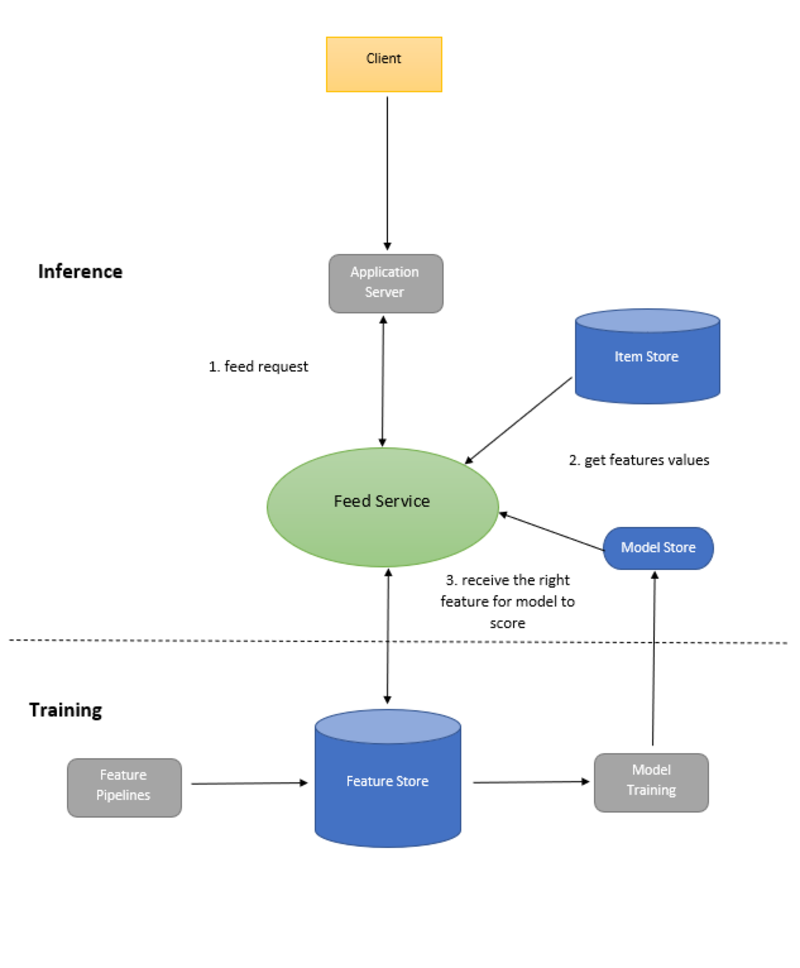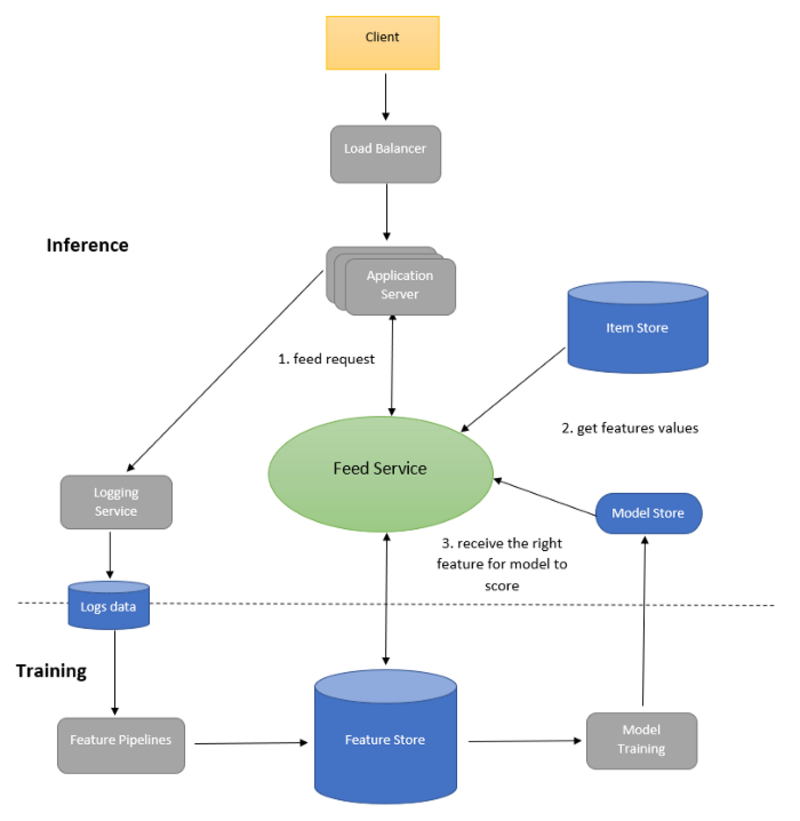How LinkedIn Uses Machine Learning To Rank Your Feed
In this post, you will learn to clarify business problems & constraints, understand problem statements, select evaluation metrics, overcome technical challenges, and design high-level systems.
LinkedIn feed is the starting point for millions of users on this website and it builds the first impression for the users, which, as you know, will last. Having an interesting personalized feed for each user will deliver LinkedIn's most important core value which is to keep the users connected to their network and their activities and build professional identity and network.
LinkedIn’s Personalized Feed offers users the convenience of being able to see the updates from their connections quickly, efficiently, and accurately. In addition to that, it filters out your spammy, unprofessional, and irrelevant content to keep you engaged. To do this, LinkedIn filters your newsfeed in real-time by applying a set of rules to determine what type of content belongs based on a series of actionable indicators & predictive signals. This solution is powered by Machine Learning and Deep Learning algorithms.
In this article, we will cover how LinkedIn uses machine learning to feed the user's rank. We will follow the workflow of a conventional machine learning project as covered in these two articles before:
The machine learning project workflow starts with the business problem statement and defining the constraints. Then it is followed by data collection and data preparation. Then modeling part, and finally, the deployment and putting the model into production. These steps will be discussed in the context of ranking the LinkedIn feed.

LinkedIn / Photo by Alexander Shatov on Unsplash
1. Clarify Bussines Problems & Constraints
1.1. Problem Statement
Designing a personalized LinkedIn feed to maximize the long-term engagement of the user. Since the LinkedIn feed should provide beneficial professional content for each user to increase his long-term engagement. Therefore it is important to develop models that eliminate low-quality content and leave only high-quality professional content. However, it is important, not overzealous about filtering content from the feed, or else it will end up with a lot of false positives. Therefore we should aim for high precision and recall for the classification models.
We can measure user engagement by measuring the click probability or known as the ClickThroughRate (CTR). On the LinkedIn feed, there are different activities, and each activity has a different CTR; this should be taken into consideration when collecting data and training the models. There are five main activity types:
- Building connections: Member connects or follows another member or company, or page.
- Informational: Sharing posts, articles, or pictures
- Profile-based activity: Activities related to the profile, such as changing the profile picture, adding a new experience, changing the profile header, etc.
- Opinion-specific activity: Activities that are related to member opinions such as likes or comments or reposting a certain post, article, or picture.
- Site-specific activity: Activities that are specific to LinkedIn such as endorsement and applying for jobs.
1.2. Evaluation Metrics Design
There are two main types of metrics: offline and online evaluation metrics. We use offline metrics to evaluate our model during the training and modeling phase. The next step is to move to a staging/sandbox environment to test for a small percentage of the real traffic. In this step, the online metrics are used to evaluate the impact of the model on the business metrics. If the revenue-related business metrics show a consistent improvement, it will be safe to expose the model to a larger percentage of the real traffic.
Offline Metrics
Maximizing CTR can be formalized as training a supervised binary classifier model. Therefore for the offline metrics, the normalized cross entropy can be used since it helps the model to be less sensitive to background CTR:

Online Metrics
Since the online metrics should reflect the level of engagement of users when the model is deployed, we can use the conversion rate, which is the ratio of clicks per feed.
1.3. Technical Requirements
The technical requirements will be divided into two main categories: during training and during inference. The technical requirements during training are:
- Large training set: One of the main requirements during training is to be able to handle the large training dataset. This requires distributed training settings.
- Data shift: In social networks, it is very common to have a data distribution shift from offline training data to online data. A possible solution to this problem is to retrain the models incrementally multiple times per day.
The technical requirements during inference are:
- Scalability: To be able to serve customized user feeds for more than 300 million users.
- Latency: It is important to have short latency to be able to provide the users with the ranked feed in less than 250 ms. Since multiple pipelines need to pull data from numerous sources before feeding activities into the ranking models, all these steps need to be done within 200 ms. Therefore the
- Data freshness: It is important that the models be aware of what the user had already seen, else the feeds will show repetitive content, which will decrease user engagement. Therefore the data needs to run really fast.
1.4. Technical challenges
There are four main technical challenges:
- Scalability: One of the main technical challenges is the scalability of the system. Since the number of LinkedIn users that need to be served is extremely large, around 300 million users. Every user, on average, sees 40 activities per visit, and each user visits 10 times per month on average. Therefore we have around 120 billion observations or samples.
- Storage: Another technical challenge is the huge data size. Assume that the click-through rate is 1% each month. Therefore the collected positive data will be about 1 billion data points, and the negative labels will be 110 billion negatives. We can assume that for every data point, there are 500 features, and for simplicity of calculation, we can assume every row of features will need 500 bytes to be stored. Therefore for one month, there will be 120 billion rows, each of 500 bytes therefore, the total size will be 60 Terabytes. Therefore we will have to only keep the data of the last six months or the last year in the data lake and archive the rest in cold storage.
- Personalization: Another technical challenge will be personalization since you will have different users to serve with different interests so you need to make sure that the models are personalized for each user.
- Content Quality Assessment: Since there is no perfect classifier. Therefore some of the content will fall into a gray zone where even two humans can have difficulty agreeing on whether or not it’s appropriate content to show to the users. Therefore it became important to combine man+machine solutions for content quality assessment.
2. Data Collection
Before training the machine learning classifier, we first need to collect labeled data so that the model can be trained and evaluated. Data collection is a critical step in data science projects as we need to collect representative data of the problem we are trying to solve and to be similar to what is expected to be seen when the model is put into production. In this case study, the goal is to collect a lot of data across different types of posts and content, as mentioned in subsection 1.1.
The labeled data we would like to collect, in our case, will click or not click labeled data from the user's feeds. There are three main approaches to do collect click and no-click data:
- Rank user’s feed chronically: The data will be collected from the user feed, which will be ranked chronically. This approach can be used to collect the data. However, it will be based on the user's attention will be attracted to the first few feeds. Also, this approach will induce a data sparsity problem as some activities, such as job changes, rarely happen compared to other activities, so they will be underrepresented in your data.
- Random serving: The second approach will be randomly serving the feed and collecting click and no click data. This approach is not preferred as it will lead to a bad user experience and non-representative data, and also it does not help with the data sparsity problem.
- Use an algorithm to rank the feed: The last approach we can use is to use an algorithm to rank the user's feed and then use permutation to randomly shuffle the top feeds. This will provides some randomness to the feed and will help to collect data from different activities.
3. Data Preprocessing & Feature Engineering
The third step will be preparing the data for the modeling step. This step includes data cleaning, data preprocessing, and feature engineering. Data cleaning will deal with missing data, outliers, and noisy text data. Data preprocessing will include standardization or normalization, handling text data, dealing with imbalanced data, and other preprocessing techniques depending on the data. Feature Engineering will include feature selection and dimensionality reduction. This step mainly depends on the data exploration step as you will gain more understanding and will have better intuition about the data and how to proceed in this step.
The features that can be extracted from the data are:
- User profile features: These features include job title, user industry, demographic, education, previous experience, etc. These features are categorical features, so they will have to be converted into numerical as most of the models cannot handle categorical features. For higher cardinality, we can use feature embeddings, and for lower cardinality, we can use one hot encoding.
- Connection strength features: These features represent the similarities between users. We can use embeddings for users and measure the distance between them to calculate the similarity.
- Age of activity features: These features represent the age of each activity. This can be handled as a continuous feature or can be binned depending on the sensitivity of the click target.
- Activity features: These features represent the type of activity. Such as hashtags, media, posts, and so on. These features will also be categorical, and also as before, they have to be converted into numerical using feature embeddings or one hot encoding depending on the level of cardinality.
- Affinity features: These features represent the similarity between users and activities.
- Opinion features: These features represent the user's likes/comments on posts, articles, pictures, job changes,s and other activities.
Since the CTR is usually very small (less than 1%) it will result in an imbalanced dataset. Therefore a critical step in the data preprocessing phase is to make sure that the data is balanced. Therefore we will have to resample the data to increase the under-represented class.
However, this should be done only to the training set and not to the validation and testing set, as they should represent the data expected to be seen in production.
4. Modeling
Now the data is ready for the modeling part, it is time to select and train the model. As mentioned, this is a classification problem, with the target value in this classification problem being the click. We can use the Logistic Regression model for this classification task. Since the data is very large, then we can use distributed training using logistic regression in Spark or using the Method of Multipliers.
We can also use deep learning models in distributed settings. In which the fully connected layers will be used with the sigmoid activation function applied to the final layers.
For evaluation, we can follow two approaches the first is the conventional splitting of the data into training and validation sets. Another approach to avoid biased offline evaluation is to use replayed evaluation as the following:
- Assume we have training data up to time point T. The validation data will start from T+1, and we will order their ranking using the trained model.
- Then the output of the model is compared with the actual click, and the number of matched predicted clicks is calculated.
There are a lot of hyperparameters to be optimized one of them is the size of training data and the frequency of retaining the model. To keep the model updated, we can fine-tune the existing deep learning model with training data of the recent six months, for example.
5. High-Level Design
We can summarize the whole process of the feed ranking with this high-level design shown in figure 1.
Let's see how the flow of the feed ranking process occurs, as shown in the figure below:
- When the user visits the LinkedIn homepage, requests are sent to the Application server for feeds.
- The Application server sends feed requests to the Feed Service.
- Feed Service then gets the latest model from the model store and the right features from the Feature Store.
- Feature Store: Feature store, stores the feature values. During inference, there should be low latency to access features before scoring.
- Feed Service receives all the feeds from the ItemStore.
- Item Store: Item store stores all activities generated by users. In addition to that, it also stores the models for different users. Since it is important to maintain a consistent user experience by providing the same feed rank method for each user. ItemStore provides the right model for the right users.
- Feed Service will then provide the model with the features to get predictions. The feed service here represents both the retrieval and ranking service for better visualization.
- The model will return the feeds ranked by CTR likelihood which is then returned to the application server.

Figure 1. LinkedIn feed ranking high-level design.
To scale the feed ranking system, we can put a Load Balancer in front of the Application Servers. This will balance and distribute the load among the several application servers in the system.

Figure 2. The scaled LinkedIn feed ranking high-level design.
6. References
- Strategies for Keeping the LinkedIn Feed Relevant
- Machine Learning Design Interview
Youssef Hosni is Co-Founder at Elfehres, Ph.D. Researcher - Computer vision, and Data Scientist
Original. Reposted with permission.
